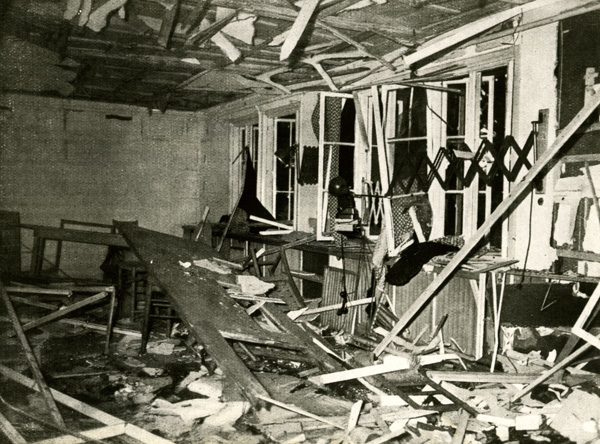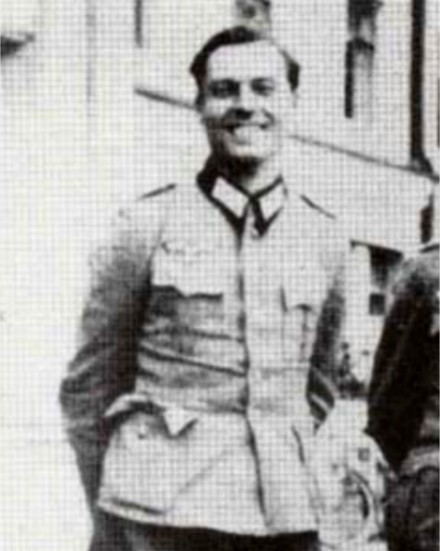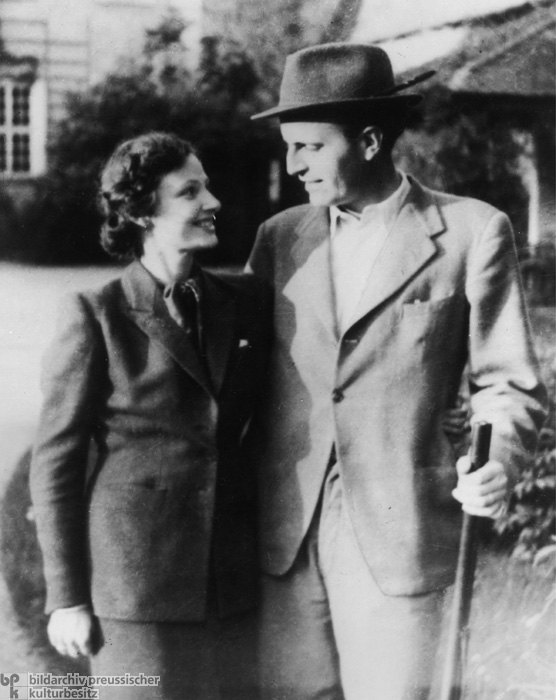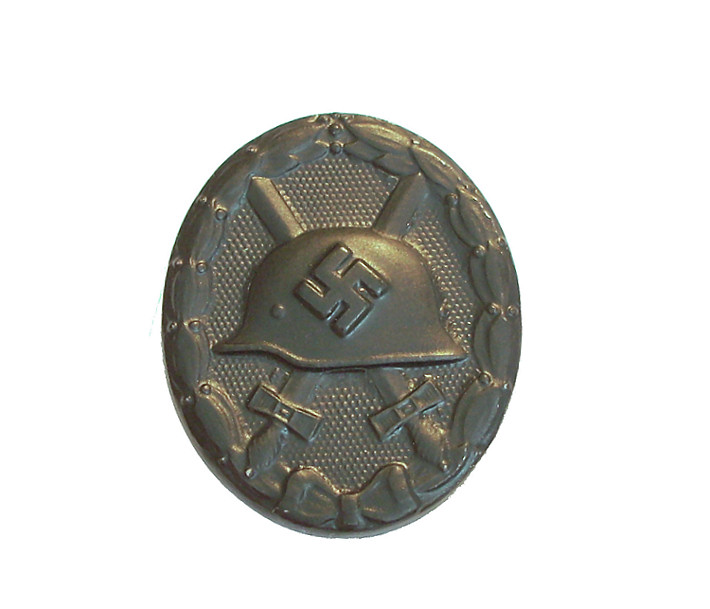1944年7月20日,德國陸軍上校施陶芬伯格與 一些反戰的德國軍官發動了刺殺希特勒的行動,但不幸失敗。事後,涉案的德國軍官幾乎全被黨衛軍殘酷處死。記者在紀念日之前采訪了德國抵抗運動紀念館館長施泰恩巴赫教授,他講述了關於施陶芬伯格刺殺希特勒的一些鮮為人知的細節。今年德國將舉行各種活動,隆重紀念二戰中因反抗納粹而犧牲的人士。如何評價刺殺希特勒的行動在德國史學界、甚至在政界有過較長時間的爭論,真心紀念這一反戰事件也才是近十年的事情。
刺殺希特勒
1944年7月20日早上8點,施陶芬伯格從柏林登上軍用飛機前往地名為“狼窩”的一個位於波蘭偏僻樹林裡的納粹指揮部,這裡四周布滿了地雷,時刻有警衛和狼狗在監視。10點30分,飛機在“狼窩”軍用機場降落,施陶芬伯格手提公文包經過三道崗哨進入“狼窩”的中心,在這個公文包中藏有兩顆重1950克的炸彈。參加希特勒親自主持的軍事會議的軍官們紛紛坐在一起吃著豐盛的早餐。會議預計在中午13點開始,施陶芬伯格必須在開會前啟動定時炸彈的點火裝置,這樣炸彈將在15分鐘後起爆。然而希特勒12點半鐘來到會議室並決定立即召開會議,因為他會後還要會見意大利首相墨索裡尼。希特勒提前開會的決定把施陶芬伯格搞得措手不及,他急忙躲到一處著手組裝炸彈。有幾位軍官甚至從他附近走過,看見他在包什麼東西,但誰能想到,施陶芬伯格竟敢在希特勒的指揮部組裝炸藥,而且他是位眾人皆知人物,1943年他在突尼斯的一次戰鬥中嚴重受傷,炮彈炸斷了他的右手,左手只剩下三個指頭,右眼完全失明。由於他指揮正確、作戰英勇很受希特勒賞識。希特勒曾表揚他是一個有思想、很理智的指揮官。因此沒有人會懷疑施陶芬伯格在做什麼“壞事”。對施陶芬伯格這樣一個殘疾人來說,要在幾分鐘內組裝好炸彈有多麼困難。匆忙中施陶芬伯格只裝配了一枚炸彈就趕往會議室。施陶芬伯格本來開會就經常遲到,這次晚來也沒有引起別人的注意。他主動上前與正在講話的希特勒握了一下手,並把裝有炸彈的公文包放在希特勒旁邊的桌子腿前,兩分鐘後施借口打個電話離開了會議室。幾分鐘後轟隆一聲巨響,會議室籠罩在煙塵中,碎片橫飛,喊聲頓起,數名軍官被炸得血肉模糊,一個軍官被汽浪彈出了窗外。在參會的24人中有4人當場死亡,水泥屋頂坍塌了一半,地板上炸出一個大坑,但希特勒只是受了輕傷。由於施陶芬伯格只使用了一枚炸彈,而不是原計劃中的兩枚,炸彈缺乏足夠的威力,特別是厚重的橡木桌面成了希特勒的保護屏障,在炸彈爆炸時希特勒正趴在桌子的軍用地圖上看著什麼,這使他躲過一劫。
從希特勒的擁護者到行刺人
施陶芬伯格1907年出生在德國一個貴族家庭,他父親是德國皇家軍隊的將軍,他從小生活環境優越,中小學上的是貴族學校。1923年他15歲時就曾在一篇作文中寫到,他要為德意志人民去戰鬥。希特勒上台前他畢業於德國軍事學院,不久就加入了國防軍。早期的施陶芬伯格是一名納粹的崇拜者,他十分贊賞希特勒關於純淨德意志民族的說法,以能為希特勒作戰為榮。甚至在結婚時他也一身戎裝,他說,軍人在任何時候都是軍人,婚禮也不例外。在渡婚假時他選擇去羅馬參加莫索裡尼執政10周年紀念儀式。施陶芬伯格學歷高,聰明能干,組織能力強,很快就被提拔為高級軍官。但他慢慢地開始對納粹黨徒們的橫行霸道,尤其對希特勒在軍事上的喪心病狂深為不滿和厭惡。1943年底,德軍在各個戰場上已開始節節敗退,成千上萬的德國士兵死於他鄉,而希特勒卻更加一意孤行。從這時起施陶芬伯格經常說,我必須采取行動拯救我們的國家,只有一個辦法就是除掉希特勒。通過朋友的介紹施陶芬伯格結識了軍隊中的反納粹小組成員,他們是一批對納粹深惡痛絕的德國軍人,正在密謀策劃暗殺希特勒的行動。從此施陶芬伯格積極參與了策劃暗殺希特勒的准備活動。他們的打算是,除掉希特勒,接管政府,組成以貝克將軍為首的臨時機構並與反法西斯盟國進行談判,簽訂和約。1944年7月1日施陶芬伯格被任命為國內駐防軍總司令部最高長官,從而有了接觸希特勒的機會,從7月初起施陶芬伯格就一直把炸藥放在公文包中,准備見機行事炸死希特勒。在7月中旬他曾三次與希特勒直接接觸,但由於希特勒的左膀右臂戈林和希姆萊不在場,而未下決心動手,因為反納粹小組堅持把希特勒及其主戰骨干一網打盡。
7月20日施陶芬伯格將再暗殺行動失敗後,希特勒立即展開血腥報復。當夜凌晨施陶芬伯格等四名主要參案者被槍決,死時施陶芬伯格只有35歲,隨後110名涉案軍官被捕。在後來的幾天裡有過反納粹言行的5000多人被投入監獄。凡是參與暗殺希特勒的軍官都慘遭“蓋世太保”的酷刑後被害,這些人要麼被鋼琴上的金屬絲吊死,要麼被用鉤子鉤死。處死的部分過程被拍攝下來,供希特勒細細“欣賞”。據德國史書記載,被殺的100多名德國軍官沒有一個人對自己的行動表示懺悔,他們默默寫下遺囑,高呼口號英勇就義。
應該說1944年7月20日的這次刺殺希特勒行動是德國反抗納粹統治的一次重要標志,但很多德國人並沒有把它看作是理所當然的紀念日。到了二十世紀60年代有一半以上的人不同意用施陶芬伯格的名字命名任何一所學校或街道。一些人甚至把施陶芬伯格這些人稱為叛國者。一個曾經參加過刺殺希特勒的人從當時的西德跑到東德,德國輿論竟稱,當過一次叛國者的人永遠是叛國者。直到1983年有關部門才開始把反法西斯的歷史資料集中存放起來,以示重視。但很大一部分史學家堅持認為,在第二次世界大戰時反對希特勒的只是少數對納粹行為不滿的人,並沒有形成真正的反戰力量。因此當時很多文字在描述“7?0”行動時都使用貶義的“政變”字眼。長時間以來不少德國人仍然不願意特別談及第三帝國和二戰。直到80年代後期,德國領導人開始正視德國二戰的歷史。德國總理施羅德曾講過,如果現在的青少年連那段歷史都不知道,我們怎麼能避免歷史重演呢?那些長眠地下的受害者怎麼會瞑目呢?這段歷史又怎能用“不堪回首”四個字了得?

施陶芬伯格(左)和阿湯哥扮演的劇照(中)和阿湯哥本人照片(右)比較。

1936年

紀念館中的施陶芬伯格辦公室。


參觀者站在原先的施陶芬伯格辦公室內觀看歷史照片,現在為柏林德國抵抗力量紀念中心的一部分。

德國抵抗力量紀念中心的一面紀念牆,上面貼滿了參與刺殺希特勒行動的其他德國官員照片

槍決施陶芬伯格後出具的死亡證明,槍殺於班貝格(Bamberg)。(1951年出具)

施陶芬伯格與兩個女兒。

1933年與尼娜合影

1942年

施陶芬伯格三兄弟與父親

戈林、鮑曼等查勘爆炸現場。

希特勒查勘爆炸現場。

爆炸後的現場清晰照片。

Nina,1929
紀念碑

1953年7月20日,紀念德國抵抗力量大會。
左2:施陶芬伯格的兒子貝爾索爾特,中;尼娜,右2:菲利特裡希-奧爾布裡希特將軍的遺孀,愛娃。


位於東普魯士拉斯特堡的希特勒指揮部 - 狼窩,希特勒接見將領,最左面的是施陶芬伯格。
(Wolfs Lair) at Rastenburg in East Prussia

尼娜和孩子們1942年

合影

尼娜寫的回憶錄封面

Nina,2003年,尼娜90歲時的合家歡

1933年

1924年

1933年結婚典禮

紀念郵票

20周年紀念會會場,1964年,柏林

施陶芬伯格雕像。

施陶芬伯格在柏林的家。


左;施陶芬伯格就在這個院子裡被處決。右:720事件死難者紀念碑(1964年樹立)

1954年阿登納出席10周年紀念活動

立在該院子裡的“720事件死難者紀念銅像”

1984年720事件40周年紀念活動

1999年55周年紀念活動。

刺殺希特勒計劃核心成員中唯一的幸存者,菲利浦-巴隆-博伊施拉格(Philipp Baron von Boeselager)
和其妻子露絲(Rosy Baroness von Boeselager) 一起參觀紀念中心。
菲利普已經於2008年5月2日夜去世,享年90歲。

刺殺事件後被處死的另一名成員,外交部官員Adam von Trott zu Solz
附;施陶芬伯格英文小傳
Claus von Stauffenburg Oberst (Colonel) Claus Philip Maria Schenk Graf von (Count of) Stauffenberg (15 November 1907 - 20 July 1944) - the tall, dynamic German aristocrat and Army officer, leading figure of the failed Army-based coup of 1944 (the July 20 Plot) against the Nazi regime during WW II.

Claus von Stauffenberg He was born the third of three sons in Jettingen in Swabia near Ulm, in the state of Baden- Wurttemberg to one of the oldest and most distinguished aristocratic South German Catholic families. Among his ancestors were several famous Prussians, including most notably August von Gneisenau. His name points to the imperial Stauffen Berg mountain and castle. Stauffenberg was very well educated and was inclined to literature but eventually took up a military career. In 1926 he joined the family regiment in Bamberg, the Reiter- und Kavallerieregiment 17 (17th Cavalry Regiment). In 1933 Adolf Hitler came to power and while some aspects of the party were repugnant to him, he was not initially in complete opposition to their ideas, especially in the area of nationalism. However after Kristallnacht in November 1938 he felt that great shame had been brought upon Germany and it had deeply offended his sense of morality and justice. The treatment of the Jews and the suppression of religion in Germany made Stauffenberg more and more an opponent of the Nazis.
In the military, he had worked his way through the grades and on 1 January 1937 he was promoted to Hauptmann (captain), a rank he would hold for the next six years. His regiment became part of the Sixth Panzer Division and was involved in the occupation of the Sudetenland and, once war broke out, in the Polish, French and Russian campaigns. Towards the end of the French campaign (31 May 1940) he was awarded the Iron Cross First Class.
On 1 January 1943 he was promoted to Oberstleutnant (lt. colonel) and was soon transferred to the North African campaign. There while he was scouting out a new command area his vehicle was strafed by marauding Allied fighter-bombers and he was severely wounded. He spent three months in hospital and ended up losing his left eye, his right hand and the fourth and fifth fingers of his left hand - though he later joked that he hardly knew what he had done with all ten fingers when he had them.
While his uncle, Graf Niklaus von 舚xkull, approached him to join the resistance movement after the Polish campaign in 1939, it was Stauffenberg's individual conscience and his religious convictions that urged him to act. Initially he felt powerless as he was in no position of authority to help organise a coup, but finally in 1943 after recuperating from his wounds he was posted as a staff officer to the Replacement Army located in an office on the Bendlerstrasse in Berlin. Here, one of his superiors was General Friedrich Olbricht, a committed member of the resistance movement. In the Replacement Army they had a unique opportunity to launch a coup as one of its functions was to have "Operation Valkyrie" in place - a contingency measure to which would let the Replacement Army assume control of the Reich in the event of internal disturbances where communications with the military high command were blocked. Ironically, this plan had been agreed to by Hitler and was now secretly to become the means of sweeping him from power.
While Stauffenberg's part in the plan required him to be at the Bendlerstrasse office to telephone regular Army units from around the Reich to arrest leaders of political organisations such as the Sicherheitsdienst and the Gestapo, in the end Stauffenberg was the only one of the conspirators who had regular access to Hitler, at his briefing meetings. Even with only three fingers remaining, Stauffenberg, in 1944 now promoted to Oberst (colonel), agreed to carry out the assassination of the German Fuhrer Adolf Hitler himself. The attempt took place at the Fuhrer's briefing hut at the military high command in Rastenburg, East Prussia on July 20, 1944. Von Stauffenberg's briefcase was packed with explosives and a simple ten to fifteen minute timer set. He entered the briefing room where Hitler was present, placed the briefcase under the table and then quickly left the room unnoticed. From a nearby shelter he waited until the explosion tore through the hut and from what he saw, he was convinced that no one could have survived such a blast. He and his aide de camp, Leutnant Werner von Haeften, quickly walked away and talked their way out of the heavily guarded compound to fly back to Berlin in a waiting Heinkel He 111. While in transit, an order was issued from the Fuhrer's headquarters to shoot them down, but the order landed on the desk of a fellow-conspirator, Friedrich Georgi of the air staff, and was not passed on.
Hitler survived the attempt on his life and once he broadcast a message on the state radio it became obvious that the coup attempt had failed. Shortly afterwards the conspirators were overpowered in their Bendlerstrasse office, with Stauffenberg being shot in the shoulder.
General Friedrich Fromm, Commander-in-Chief of the Replacement Army and himself a suspected conspirator who was later executed, held an impromptu court martial and condemned the ringleaders of the conspiracy to death. Stauffenberg along with fellow officers General Olbricht, Leutnant von Haeften and Oberst Albrecht Quirnheim were later shot that night by firing squad in the courtyard of the Bendler-Block (War Ministry). As his turn came, Stauffenberg spoke his last words: 'Es lebe unser geheimes Deutschland!' ('Long live our secret Germany!') His eldest brother Berthold, another central figure in the plot was executed later.
Today Claus von Stauffenberg is celebrated as a hero and symbol of the German resistance to the Nazi regime. Since the war the Bendler-Block has become a memorial to the failed anti-Nazi resistance movement. The street's name was ceremonially changed from "Bendlerstrasse" to "Stauffenbergstrasse" and the Bendler-Block now houses a permanent exhibition with more than 5,000 photographs and documents showing the various resistance organisations at work during the Hitler era. The courtyard where the officers were shot is now a site of remembrance with a plaque commemorating the events and a memorial bronze figure of a young man with his hands symbolically bound.
《行動代號:華爾奇麗雅》(英語:Valkyrie)是2008年上映的歷史驚悚電影,由
布萊恩·辛格執導,
湯姆·克魯斯主演。此電影是由真人真事(
7月20日密謀案)改編。此計劃內容為一些德國軍官欲刺殺
阿道夫·希特勒,是辛格和克里斯多福·麥考里的聯袂合作。湯姆·克魯斯會在電影中飾演德國一名上校——
克勞斯·馮·施陶芬貝格。

華爾奇麗雅行動如果成功的話,德國就會提早投降.
德國就不會遭受到聯軍瓜分.
就不會有-東.西.兩德的產生.
今天世界上軍事強國的順序也將重新洗牌.


1939年的重傷勳章
重傷勳章(
德語: Das Verwundetenabzeichen)是德軍獎章嘉勉作戰重傷或是凍傷,全體士官兵包括:
Reichswehr、
德國國防軍、
黨衛軍、德軍相關組織用人(此相關組織用人是自
1943年後3月起增加獎勵條款,因應
盟軍空襲頻頻轉烈,德國平民傷者增加)皆有資格得獎。
第二次世界大戰時它出現三樣款式:「
黑色」代表因為戰爭敵軍攻擊或空襲負傷兩次,或是在前線固守戰鬥崗位遭到凍傷者;「
銀色」代表負傷三至四次,因為戰爭敵軍攻擊或空襲、凍傷導致「斷手或斷腳或瞎一隻眼、聽力減弱、毀容、腦殘智障」皆可得獎,「
金色」(包括作戰陣亡)為傷五次(含)以上全盲、失智皆可得獎;勳章材質有純
鋼、
黃銅與
鋅都是純粹金屬製品;德軍在
第一次世界大戰起就頒發這獎章,但是當時雕工較為粗製。
所有版本的「重傷獎章」一律佩掛在冬天軍大衣或是夏天戎裝左胸略低處:也包括得獎平民衣物。
第二次世界大戰時德國軍民得到這獎章不少於5百萬人(當時德國總人數4700萬人);
1957年時德國政府明令可佩掛二戰時期獎章;但勳章上有「
卐」字都需磨滅才准佩帶。
版面上照片是
第二次世界大戰時此獎章照片。
1944年7月20日密謀案重傷勳章
7月20日「重傷獎章」是這一系列勳章裡最珍貴的,所以珍貴是因為一批得獎人都是在1944年7月20日這一天在
東普魯士Rastenburg山上的「狼穴」司令部、也是希特勒別墅發生炸彈暗殺
希特勒失敗,連同傷亡人員贈予勳章;現場24人(包括希特勒)紛受不同程度炸傷無一倖免:一名軍官當場殞命另外還有3位送醫傷重不治;希特勒歡喜相信「天不亡他」,便又專門精工打造特別款式「重傷勳章」給負傷及殞命每一位以茲紀念;就是典故由來。
「7月20日重傷獎章」與「重傷勳章」大同小異,不同的是勳章裡
鋼盔稍微高與大,並刻印日期「20 Juli 1944」,在鋼盔與日期下方還刻有希特勒親筆簽名。
「7月20日重傷獎章」等級也是比照:「黑銀金」三級制;本來已經得到過「重傷勳章」者,此次「7月20日重傷獎章」等級再加一級。
不像一般「重傷勳章」黑級,「7月20日重傷獎章」沒有全黑式樣,是略略淺黑與其他色彩,日期與希特勒簽名刻印也位於顯而易見位置。
希特勒頒獎給每一位傷亡者勳章與與得獎證書,並於同年
9月21日舉行盛大頒獎受勳典禮;雖然他也受傷,可是他並沒有把獎章頒贈給自己,所有勳章他都配掛於身過,包括在
第一次世界大戰他作戰負傷的確得到過「重傷勳章」;他唯一一次贈勳給自己是「
納粹黨金獎章」,但是這是政治獎章不是軍事勳章。
四位命喪者也都收到
金級「7月20日重傷獎章」,由家屬代收。
受贈「7月20日重傷獎章」日後又得「重傷獎章」都可再升一級(即:黑升為銀,銀升為金);結果德軍海軍
上將(後來陞官)
漢斯-埃里希·沃斯,原先就有「重傷獎章」此次「7月20日重傷獎章」升為銀級,日後兩次作戰又負傷又升級,共得到過3次「重傷獎章」,且憑勳章助力官階跳兩級,自
少將成為
上將。